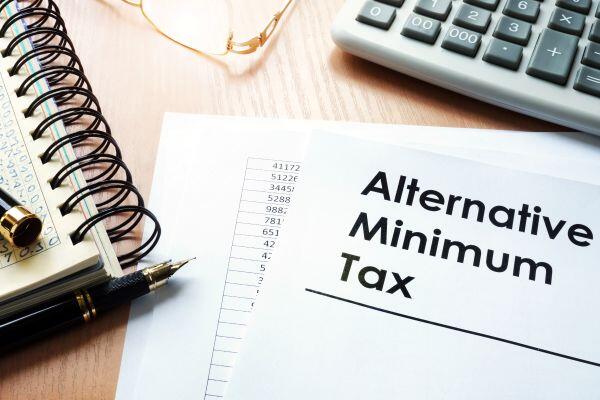Navigating the Alternative Minimum Tax: Essential insights for tax professionals

Ah, the dreaded Alternative Minimum Tax! The “we did not get enough tax on the first round, so let’s start from the top” tax. Let’s unpack the history and purpose of the alternative minimum tax, how to calculate the tax, and strategies to avoid paying the additional income tax.
What is the Alternative Minimum Tax
The AMT is a separate and parallel system to the regular tax computation. It is a second tax base that captures economic income rather than regular tax income and has a broader base than the regular tax base to ensure that all taxpayers with income pay some minimum income tax each year. The additional tax is targeted at individuals with higher incomes who benefit from tax saving items such as deductions and exclusions.
All individual taxpayers subject to regular income tax are also subject to AMT (IRC Section 55(b)).
The history of the Alternative Minimum Tax
The “minimum tax,” the predecessor of the current Alternative Minimum Tax (AMT), was introduced in 1969. The original tax targeted a small group of wealthy individuals who avoided paying income tax in a prior tax year. Specifically, Treasury Secretary Barr noted in his address to the Joint Economic Committee of Congress in 1969 that 155 taxpayers with income over $200,000 paid no tax in 1966i.
IRC Sections 56, 57, and 58 were added by the 1969 Tax Reform Act. The 1986 Tax Reform Act restructured and expanded the individual AMT code sections. The 1997 Taxpayer Relief Act simplified the calculation of the AMT. Since 1997, legislation has updated the AMT almost annually. Most recently, the 2017 Tax Cuts and Jobs Act (TCJA)ii increased the AMT exemption amounts and the exemption amount phaseout thresholds for years 2018-2025iii.
How does the Alternative Minimum Tax work?
The AMT calculation begins with regular taxable income. Adjustments are mostly added (sometimes subtracted) from the regular taxable income to arrive at the more inclusive AMT income. Subtract the AMT exemption from the AMT income to compute the AMT tax base. The AMT tax base multiplied by the current AMT tax rates of 26% and 28% equals the tentative minimum tax. If the tentative minimum tax is higher than the regular tax, then this amount is the AMT.
| Alternative Minimum Tax | |
| Regular taxable income | |
| + | Standard deduction, if taken (IRC Section 56) |
| +/- | Adjustment items (IRC Sections 56 and 58) |
| + | Tax preference items (IRC Section 57) |
| = | Alternative Minimum Taxable Income (AMTI) |
| = | AMT tax base |
| x | AMT rate |
| = | Tentative minimum tax |
| - | Regular tax |
| = | Alternative Minimum Tax (AMT) |
If the taxpayer takes the standard deduction, it's added to the regular taxable. Common adjustment items added to regular taxable income include:
- Real or personal property taxes deducted as itemized deductions
- State income or sales taxes deducted as itemized deductions
- Bargain element of stock options exercised (the difference between the fair market value at exercise and the option price)
AMT requires a different depreciation calculation and may result in adding or subtracting the difference to regular taxable income.
It is significant to observe that both bonus depreciation and the Section 179 immediate expense provision are allowed for AMT purposes. State income tax refunds that are taxable for regular tax purposes are not taxable for AMT purposes due to the application of the tax benefit rule. A state tax refund is one of the unusual examples of income that may be taxable for regular tax purposes but not for AMT and would result in a subtraction from regular taxable income.
Gains and losses on the sale of assets also result in a tax preference item due to the difference in the AMT basis of the asset calculated using the AMT depreciation rules. Notably, itemized deductions that are deductible for both regular and AMT purposes include common deductions such as home mortgage interest and charitable contributions. In addition, long-term capital gains and qualified dividends are taxed at the same rates for regular and AMT purposes.
Changes to the AMT exemption
The AMT exemption amount was increased by the TCJA for tax years 2018-2025. The AMT exemption amounts for 2025 are $137,000 for married taxpayers filing jointly and surviving spouses, $88,100 for single and head of household taxpayers, and $68,500 for married individuals filing separately. Phaseout for the exemptions begins at AMT income of $1,252,700 for MFJ and $626,350 for all others. AMT rates for 2025 are 26% on AMT income up to $239,100 ($119,550 for married filing separately) and 28% on AMT income above that amountiv.
IRC Section 53 allows for the Minimum Tax Credit (MTC) against regular tax liability if a taxpayer pays AMT in a year due to a timing difference. The MTC equals the difference between the AMT and the AMT that would have been calculated if only permanent differences had been considered in the calculation of AMT.
An example to consider is incentive stock options. AMT includes the bargain element as income in the year of the exercise of the stock options. Regular tax rules tax this bargain element amount when the taxpayer sells the stock received in the exercise through the stock's lower basis. A taxpayer who is subject to AMT in the year the stock option was exercised but not in the year the stock was sold essentially pays tax on the income twice. The MTC allows a credit against regular taxable income to remedy the situation. The credit is claimed on Form 8801, Credit for Prior Year Minimum Tax- Individual Estates and Trustsv and can be carried forward to unlimited future tax years.
Looking ahead with the AMT
The most recent significant impact on the AMT was the TCJA. Before TCJA, over 5 million taxpayers filed a tax return subject to AMT compared to only 200,000 in 2018 after TCJA took effect. The AMT provision was set to expire at the end of 2025, and the Congressional Budget Office projected that 7.3 million taxpayers would be subject to the AMT in tax year 2026vi . However, the One Big Beautiful Bill Act was signed into law at the beginning of July, which permanently extends the higher AMT exemption amounts from TCJA, and the exemption amounts will be adjusted for inflation starting in 2026.
Tax planning and the Alternative Minimum Tax
What are some general strategies to avoid paying alternative minimum tax?
For taxpayers claiming the standard deduction, it may be beneficial to analyze whether itemizing deductions (despite resulting in a lower deduction for regular tax) could lead to a more favorable AMT and overall tax outcome. This consideration has become more relevant since the TCJA significantly increased the standard deduction. Taxpayers who take the standard deduction for regular tax purposes cannot claim itemized deductions for AMT purposes. Moreover, only select itemized deductions are permitted under AMT rules.
Encourage clients to prioritize deductions allowed under both tax systems, such as charitable and retirement plan contributions. An AMT-triggering year may present an optimal opportunity to make charitable donations and maximize contributions to retirement accounts.
Determining when to exercise incentive stock options (ISO) warrants a more technical approach. ISOs can substantially impact AMT liability, as the bargain element is includable in income for AMT purposes, but not for regular tax. Calculate the taxpayer's "AMT crossover point," the additional income that subjects the taxpayer to paying AMT. This calculation will help determine when to exercise incentive stock options and how many options to exercise in a specific tax year.
Learn more about the AMT with CPE courses
What began as an additional tax to ensure wealthy individuals pay a minimum amount of income tax has evolved over the years to today’s version of the Alternative Minimum Tax. A comprehensive understanding of the Alternative Minimum Tax and its application is a critical tool for tax advisors in delivering value-added guidance to clients.
With CPE courses and IRS-approved CE courses available as both live webcasts and on-demand, Becker offers a convenient, flexible way to build your tax knowledge and achieve better outcomes for your clients. Check out the following options to learn more about the topics that matter most:
- i Economic Report of the President, Part I, January 17, 1969, https://www.jec.senate.gov/reports/91st%20Congress/The%201969%20Economic%20Report%20of%20the%20President%20Part%20I%20(436).pdf
- ii U.S. Congress. (2017) Tax Cuts and Jobs Act, Pub. L. No. 115-97, 131 Stat. 2054. https://www.congress.gov/bill/115th-congress/house-bill/1
- iii Ferguson, M. C., & Peschel, J. L. (2021). Noncorporate alternative minimum tax (Tax Management Portfolio No. 587-3rd). Bloomberg BNA.
- iv Internal Revenue Service. (2024). Revenue Procedure 2024-40. Internal Revenue Bulletin 2024-23.
- v Internal Revenue Service. (2024). Form 8801: Credit for Prior Year Minimum Tax – Individuals, Estates, and Trusts. U.S. Department of the Treasury. https://www.irs.gov/forms-pubs/about-form-8801
- vi Lautz, A., & Fano, A. (2025, April 9). The 2025 tax debate: The alternative minimum tax in TCJA. Bipartisan Policy Center. https://bipartisanpolicy.org/explainer/the-2025-tax-debate-the-alternative-minimum-tax-in-tcja/
- vii U.S. Congress. (2025). One Big Beautiful Bill Act, H.R. 1, 119th Cong. Retrieved from https://www.congress.gov/bill/119th-congress/house-bill/1








